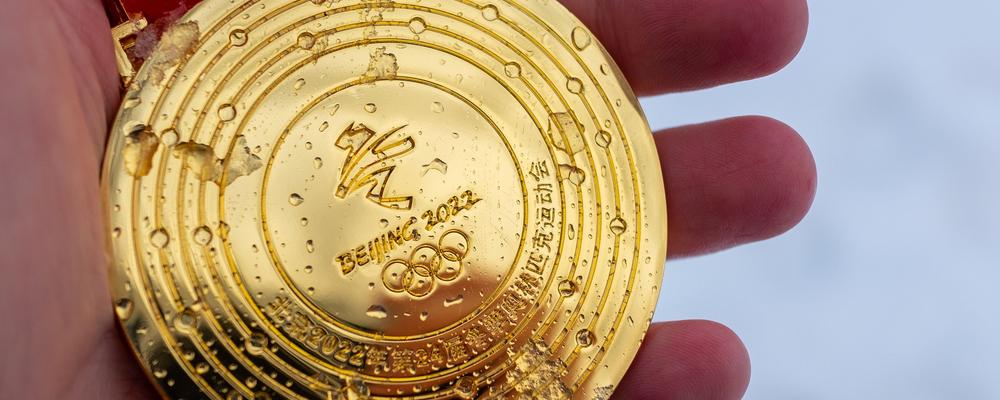In February in Beijing, 109 elite athletes will each receive a coveted gold medal, which may represent the pinnacle of their sports career. More than 200 medal winners will have to settle for a silver or a bronze medal. While gold and silver are pure metals, the bronze medal consists of an alloy of copper and tin. Usually, 10 to 20 per cent is tin, which is added to pure copper to produce the classic composition and colour of bronze.
“They chose bronze for the third-place medal instead of pure copper because a copper medal would turn green after only a few years. The medallist would likely not appreciate that,” says Axel Sjöqvist, a researcher at the Department of Earth Sciences, University of Gothenburg.
Gold, silver and copper all occur in pure metallic form in nature. All have a shiny surface, but differ in colour, of course. Gold is the heaviest of the metals. One cubic centimetre of gold weighs 20 grams, while the same amount of silver weighs 11 grams and a cubic centimetre of copper weighs 9 grams.
“All three metals conduct heat and electricity. Gold and silver are very resistant to corrosion and do not cause allergic reactions. That is why they are used for ornamentation,” says Zareen Abbas, a researcher at the Department of Chemistry and Molecular Biology at the University of Gothenburg.
In the Earth’s crust, it is relatively unusual to find silver and copper in pure form.
“Silver is often a by-product of mining lead ore, and copper often constitutes the main mineral in ores like copper pyrites or bornite. As in the case of gold, silver also often occurs in copper ore,” says Axel Sjöqvist.
On average, silver occurs in the Earth’s crust in a concentration 10 times greater than gold.
“As a result, gold is more difficult to access and refine. A gold mine usually contains a few grams of gold per tonne of rock. To produce the amount needed for a gold medal from ore like that found in the Aitik mine outside of Gällivare – where Boliden mines copper and gold in low concentrations in Europe’s largest open pit mine – at least 55 tonnes of rock are needed,” says Sjöqvist.
Copper, silver and gold belong to the same group (IB) in the periodic table, which shows the order of the elements based on their atomic number. As a result, the metals share many chemical properties. Copper appears higher in the group and gold farther down, because gold has a higher atomic number, meaning it weighs more than both copper and silver.
The chemical symbol for gold is Au and for silver Ag. The symbols are derived from the Latin name of the metals. The Latin name for gold is aurum, which means “shining dawn”, and for silver it is argentum, which means “shining” or “white”. Cu, the copper symbol, has connections to the Latin name for Cyprus, where the Romans first mined the metal. At the beginning of the Bronze Age 5,000 years ago, people discovered copper could be made harder by adding tin to it.
“If you mean the medal that would be most expensive to buy, it would be rhodium,” says Axel Sjöqvist. “Rhodium is a silvery metal that resembles platinum. The price varies a great deal. Right now, a gram of it costs about SEK 3,500. One gram of gold, by comparison, costs SEK 540. Platinum is currently cheaper than gold and costs SEK 312 per gram, or one-tenth the price of rhodium. Silver costs SEK 7 per gram.”
Zareen Abbas believes that gold has gained a higher status because there is less gold than silver in nature, and it also requires more advanced mining techniques to obtain it in sufficiently large quantities.
“Due to their glittering surface, both gold and silver have always been associated with beauty and wealth. And gold coins were already in use in ancient Egypt,” says Abbas.
The medals are heavier than many people think
According to the rules of the International Olympic Committee, an Olympic medal must be at least 3 millimetres thick and 60 millimetres in diameter. In the last Winter Olympics, the bronze medal weighed 493 grams and consisted mostly of copper. The silver medal weighed 580 grams and consisted of 99.9 percent silver, known as “fine silver”, while the gold medal weighed 586 grams.
“It consisted of silver plated with six grams of gold, which accounted for about one per cent of the total weight. The gold medal is, in fact, a silver medal with a thin layer of gold,” says Sjöqvist.
Contact: Axel Sjöqvist, Department of Earth Sciences, University of Gothenburg, mobile: +46 (0)703-59 92 45, email: axel.sjoqvist@gu.se
Zareen Abbas, Department of Chemistry and Molecular Biology, University of Gothenburg, mobile: +46 (0)766-22 90 15, email: zareen.abbas@gu.se
